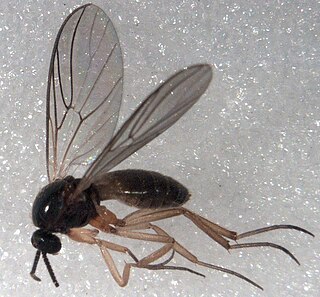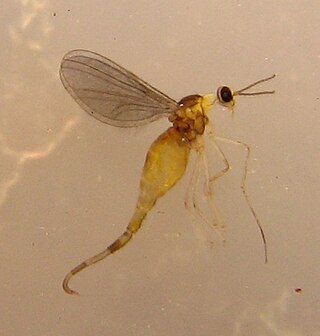
The Nematoceran family Axymyiidae is the sole member of the infraorder Axymyiomorpha, though it is often included within the infraorder Bibionomorpha in older classifications. It is known from only nine species in four genera, plus eight fossil species.
Cyclocoelidae is a family of trematodes in the order Plagiorchiida.

Cymothoa is a genus of parasitic isopod crustaceans, containing the species listed below. Not all Cymothoa species are considered parasitic. Some climb onto fish in an act known as phoresy.

Boris Yevseyevich Bychowsky was a Soviet scientist and parasitologist, specialist of fish parasites, especially monogeneans. He was director of the Institute of Zoology of the Academy of Sciences of the Soviet Union in Leningrad (1962–1974). Bychowsky is the author of more than 100 scientific publications, mostly on systematics of monogeneans. His most famous work was his monography on monogeneans (1957), which was translated into English in 1961.

Diclidophoridae is a family of monogeneans within the order Mazocraeidea.

Microcotylidae is a family of polyopisthocotylean monogeneans. All the species in this family are parasitic on fish.
Allopodocotyle is a genus of trematodes in the family Opecoelidae.

Helicometra is a genus of trematodes in the class Opecoelidae. It is synonymous with AllostenoperaBaeva, 1968, MetahelicometraYamaguti, 1971, and StenoperaManter, 1933. Its type species is H. fasciata(Rudolphi, 1819). They are distinguished by their unique spiral uterus, from which their name is derived.
Tellervotrema is a genus of trematodes in the family Opecoelidae.

Xylophagus is a genus of flies in the family Xylophagidae.
Catotricha is a genus of midges in the family Cecidomyiidae. The five described species in Catotricha are found in the holarctic region. This genus was established by British entomologist Frederick Wallace Edwards in 1938.
Monardia is a genus of wood midges, insects in the family Cecidomyiidae. The 53 described species in Monardia are grouped into three subgenera.
Haplusia is a genus of gall midges and wood midges in the family Cecidomyiidae. There are more than 20 described species in Haplusia.

Mycetobia is a genus of wood gnats in the family Anisopodidae. There are more than 20 described species in Mycetobia.

Winnertzia is a genus of gall midges and wood midges in the family Cecidomyiidae. There are more than 90 described species in Winnertzia.

Lepocreadiidae is a family of trematodes in the order Plagiorchiida.
Prospinitectus is a genus of parasitic nematodes, belonging to the family Cystidicolidae. Species of Prospinitectus are parasitic as adults in the gastrointestinal tract of Tuna fish.
Bivagina is a genus of monogeneans. As all Monogenea, species in the genus are ectoparasites that affect their host by attaching themselves as larvae on the gills of fish and grow into adult stage. This larval stage is called oncomiracidium, and is characterized as free swimming and ciliated.
Syncoelicotylinae is a subfamily within family Microcotylidae and class Monogenea.
Syncoelicotyloides is a genus of monogenean. Species of Syncoelicotyloides are ectoparasites that affect their host by attaching themselves as larvae on the gills of the fish and grow into adult stage. This larval stage is called oncomiracidium, and is characterized as free swimming and ciliated.









